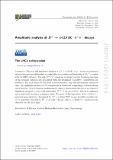Amplitude analysis of B+ → ψ(2S)K+π+π− decays
Author(s)
Aaij, R.; Abdelmotteleb, A. S. W.; Abellan Beteta, C.; Abudinén, F.; Ackernley, T.; Adefisoye, A. A.; Adeva, B.; Adinolfi, M.; Adlarson, P.; Agapopoulou, C.; Aidala, C. A.; Ajaltouni, Z.; Akar, S.; Akiba, K.; Albicocco, P.; Albrecht, J.; The LHCb collaboration; ... Show more Show less
Download13130_2025_Article_25293.pdf (3.317Mb)
Publisher with Creative Commons License
Publisher with Creative Commons License
Creative Commons Attribution
Terms of use
Metadata
Show full item recordAbstract
he first full amplitude analysis of B+ → ψ(2S)K+π+π− decays is performed using proton-proton collision data corresponding to an integrated luminosity of 9 fb−1 recorded with the LHCb detector. The rich K+π+π− spectrum is studied and the branching fractions of the resonant substructure associated with the prominent K1(1270)+ contribution are measured. The data cannot be described by conventional strange and charmonium resonances only. An amplitude model with 53 components is developed comprising 11 hidden-charm exotic hadrons. New production mechanisms for charged charmonium-like states are observed. Significant resonant activity with spin-parity JP = 1+ in the ψ(2S)π+ system is confirmed and a multi-pole structure is demonstrated. The spectral decomposition of the ψ(2S)π+π− invariant-mass structure, dominated by X0 → ψ(2S)ρ(770)0 decays, broadly resembles the J/ψϕ spectrum observed in B+ → J/ψϕK+ decays. Exotic ψ(2S)K+π− resonances are observed for the first time.
Date issued
2025-01-08Journal
Journal of High Energy Physics
Publisher
Springer Berlin Heidelberg
Citation
he LHCb collaboration., Aaij, R., Abdelmotteleb, A.S.W. et al. Amplitude analysis of B+ → ψ(2S)K+π+π− decays. J. High Energ. Phys. 2025, 54 (2025).
Version: Final published version